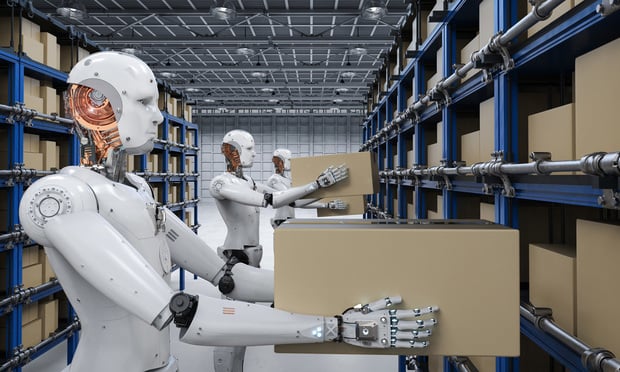CHICAGO—The average rentable building area for newly delivered warehouse product has increased by 60% nationally over the past 20 years, according to a recent report from Cushman & Wakefield. Partly this size increase is due to the larger inventories warehouses must accommodate for e-commerce flows. But another tech driver is in the mix as well: robots.
C&W believes that clearer differentiations in asset quality are likely to emerge as some technologies—such as robotics—require higher ceilings (32 to 36 feet clear) and very flat floors.
In short, this means that the warehouse of the future will not just be built for people but also for robots, C&W concluded. "Redesign of warehouses will likely include repurposing employee parking and break rooms which could be converted to logistics space, increasing the built inventory," it said. Widespread adoption of these technologies is expected to occur within the next 5-20 years, it estimates but also acknowledges that resistance from labor groups will likely slow automation.
But it is unlikely robots' momentum will be derailed or even slowed significantly, according to recent figures from ABI Research, which found that some four million commercial robots will be placed in 50,000 warehouses by 2025, up from just under 4,000 robotic warehouses last year.
The Case for Robots
The rapid rate of adoption will be driven by the need for flexible, efficient, and automated e-commerce fulfillment as same-day delivery becomes the norm, ABI Research said.
"Flexibility and efficiency have become primary differentiators in the e-commerce fulfillment market as retailers and third-party logistics struggle to cope with volatile product demand, seasonal peaks, and rising consumer delivery expectations," said Nick Finill, senior analyst at ABI Research, in prepared remarks. "Robots enable warehouses to scale operations up or down as required while offering major efficiency gains and mitigating inherent challenges associated with labor and staffing."
Automated Guided Vehicles and Autonomous Mobile Robots Goods-to-Person systems can directly replace heavier mechanized automation that typically requires massive upfront investment and rigid physical infrastructure, according to ABI.
Also, vendors, such as Fetch, Geek+, and Invia, allow for additional robots to be added to or removed from a fleet as well as reconfiguration of entire workflows and operations if product lines or fundamental operational requirements change. This is a major advantage in the unpredictable and dynamic e-commerce market, ABI Research points out.
In addition, as computer vision continues to innovate, robots are also becoming increasingly adept at performing traditionally harder-to-automate tasks. "Economically viable mobile manipulation robots from the likes of RightHand Robotics and Kindred Systems are now enabling a wider variety of individual items to be automatically picked and placed within a fulfillment operation," ABI Research said. Also by combining mobile robots, picking robots, and even autonomous forklifts, fulfillment centers can achieve greater levels of automation in an efficient and cost-effective way.
© Touchpoint Markets, All Rights Reserved. Request academic re-use from www.copyright.com. All other uses, submit a request to [email protected]. For more inforrmation visit Asset & Logo Licensing.








